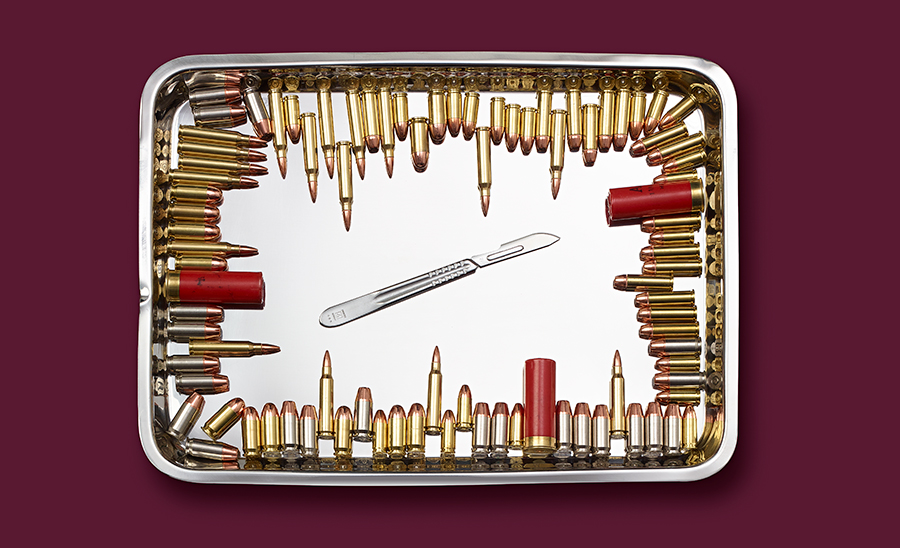Discoveries
Scalpel vs. Bullet: Expert Perspectives on Gun Trauma
Jul 17, 2019 As told to Cassie Tomlin

David Arky
Trauma surgeons are all too familiar with the devastating injuries wrought by gun violence. They rapidly analyze how each bullet has ripped through the human body so that its path of destruction can be healed. They orchestrate lifesaving efforts and cope with the aftermath, whether it be positive or tragic.
In the U.S., firearms kill about 40,000 people each year—nearly as many as road accidents or falls. But while deaths from car crashes have declined, rates of gun deaths are trending upward. “In the 1990s, when I was a resident at Los Angeles County+USC Medical Center, I saw a gunshot fracture nearly every day,” says Charles Moon, MD, director of Orthopedic Trauma. “Locally, the problem has since gotten better, but now, like the rest of the nation, gun violence is trending upward again.”
The American College of Surgeons Committee on Trauma and similar groups designate firearm violence a public health problem. Here, Cedars-Sinai trauma surgeons share what it’s like to treat gunshot victims, their medical perspectives on the increase in gun-related deaths and how they maintain objectivity on the front lines.
Director, Acute Care Surgery
Associate Director, Division of General Surgery
When a patient comes in with a gunshot wound, the situation can be very chaotic: The patient is in pain or in shock, might be screaming and there might be blood everywhere. Our job is to bring order quickly and stabilize the patient. Every minute until the bleeding is controlled is critical.1 We talk to the patient and the paramedics to get clues about how to treat the patient, including whether they know what kind of gun was used. The bullets that people and police are using now do more damage than they used to.
Semiautomatic weapons are becoming more common, and these injuries are more lethal and difficult to treat because they produce more bullet holes, and each wound itself can be life-threatening.2 The amount of violence we’re seeing—mass shootings, suicides and otherwise—is pervasive. These avoidable injuries and deaths also contribute to physician burnout because of the high-stress environment they create.3 It is really gratifying to be able to save someone who is dying right in front of you, but it doesn’t always work out that way.
1 When a bullet hits a major vein or artery, a person can bleed to death in minutes. The national Stop the Bleed campaign, in which Cedars-Sinai participates, trains civilians to save lives in emergency situations like mass shootings.
2 Semiautomatic firearms, like the AR-15, are modeled after assault rifles designed for military use. Their high-velocity bullets “bounce” around bodies, ripping through organs and bones, and are twice as likely to kill a person compared to other firearms.
3 Up to 60% of physicians experience exhaustion. Those on the front lines of care, like emergency medicine doctors, are most at risk.
Associate Director, Surgical Performance Improvement
Associate Director, General Surgery Residency Program
In 2018, I published studies linking weaker state gun laws with higher rates of suicide and gun deaths in children and young adults.1 It wasn’t easy because information isn’t reported in a consistent manner. Plus, the Centers for Disease Control and Prevention and the National Institutes of Health considerably limit funding for research about firearm violence.2 I truly understand the importance of the Second Amendment and support the right to own a firearm legally. Having said that, with the injuries I’ve seen, I believe it’s my responsibility to provide a public health service: looking into the facts of gun violence in our society. Who takes the lead on this work? Who gives voice to these injuries? As researchers, we look for the truth with rigorous, scientifically sound statistical methodology. It is my ethical duty to objectively report the data that I find.
1 One study, published in the Journal of Surgical Research, found that, of roughly 39,000 suicides considered over 14 years, nearly 60% occurred in states that had more lenient gun legislation.
2 For more than 20 years, Congress has cited the Dickey Amendment in prohibiting the use of federal funds to advocate or promote gun control.
Chief Resident, Trauma and Emergency Surgeries
As soon as my shift starts, I’m holding a trauma pager that can go off at any minute when someone comes into the emergency department because they’ve been injured or shot.1 In minutes, you could be opening someone’s chest, trying to manually pump their heart with your hands. I don’t think anyone can get used to that, but I’m sure I’ve unconsciously desensitized a little. You have a job to assess and take care of the patient, so you focus on that instead of what’s happened to them. But I think about it later, when I’m home trying to decompress and go to sleep. When someone’s injuries are severe or they don’t make it, at the end of the day, you can’t help but reflect. That person was someone’s mom, someone’s brother or sister, someone’s someone. But in the moment, you have a job and a mission, and you might be able to make them better, so you don’t think about that.
1 As a Level I trauma hospital, Cedars-Sinai is a leader in providing the highest level of care to injured patients throughout Southern California. Once a week, on average, Ruth and Harry Roman Emergency Department trauma teams race to save someone’s life after an act of gun violence or a suicide attempt. Experts continue to care for patients through intensive care and rehabilitation.

